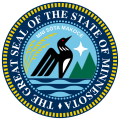| |||||||||||||||||||||
| |||||||||||||||||||||
| |||||||||||||||||||||
The 1894 Minnesota Secretary of State election was held on November 6, 1894, in order to elect the Secretary of State of Minnesota. Republican nominee Albert Berg defeated Democratic nominee Charles J. Haines, People's nominee Peter J. Seberger and Prohibition nominee Charles O. Winger. [1]

